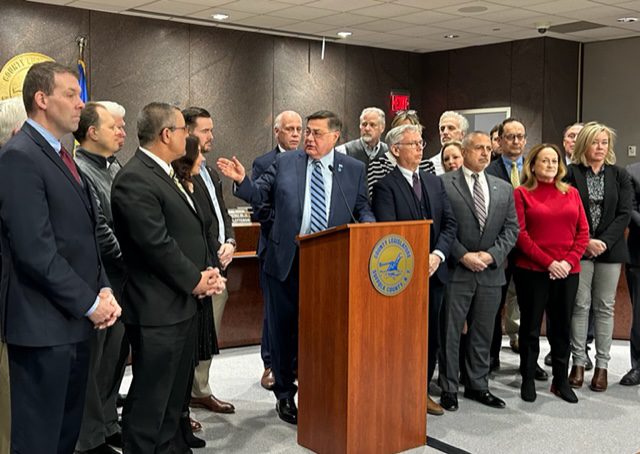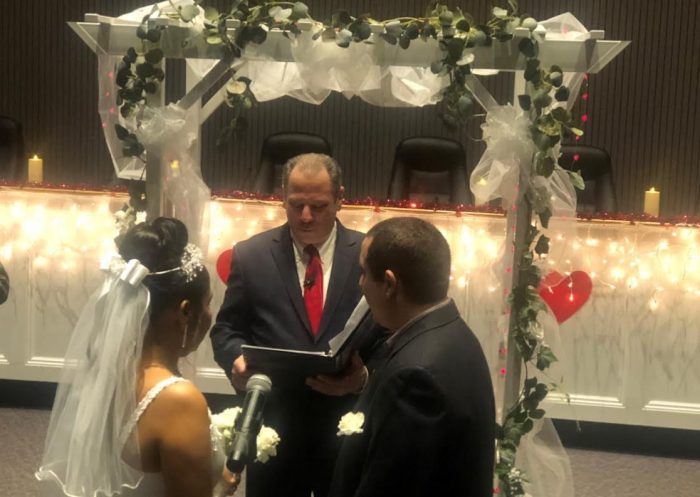Rallying against unjust state aid cuts
As many community members have already heard, Gov. Kathy Hochul [D] has proposed drastic cuts in state aid to many school districts across Long Island. Based on the governor’s proposed state aid allocations, Port Jefferson School District stands to face a total 28% cut to our state aid package, which amounts to almost $1.2 million. This is one of the largest percentage cuts for any school district on Long Island.
The governor’s proposed reductions in state aid are very concerning to us. The reduction would put a significant strain on our district. The excellence of our faculty, combined with the careful management of the district budget, has allowed us to continually deliver a high-quality education to our students. However, this proposed cut in state aid would place a significant burden on our staff and community to maintain that level of educational excellence. The governor’s proposal is patently unfair and places our district in an untenable position. It is a gross injustice to the students and taxpayers in our district and we are determined to fight back. We are calling on our state legislators to advocate and work with the governor’s office to restore our Foundation Aid to its full level.
We are asking that the community join us in this advocacy. Our website provides template letters for residents to sign and forward to the governor and our state representatives. Together, we can send a powerful message to Gov. Hochul and our local elected officials to ensure adequate and equitable funding. The Port Jefferson School District relies on these funds to support our students and maintain the integrity of our educational system.
Jessica Schmettan
Superintendent of Schools
Port Jefferson School District
Upholding the promise of public education
Every child, regardless of their ZIP code, deserves a high quality public education. Our public schools are an investment that benefits our communities and families. It is crucial that our elected leaders do not play politics with the well-being and future of our children.
It is unfortunate to see elected officials of both parties playing politics with public education funding. Gov. Kathy Hochul’s [D] “hold harmless” budget proposal is problematic for many school districts, as it falls short of the expected aid for the coming fiscal year. The state Legislature must correct this in their one house budgets and negotiations with the executive branch in determining the upcoming fiscal year budget.
However, it must be pointed out that in 2023, every Suffolk County Republican in the New York State Legislature voted against education funding. This was a year where there was record funding for public education, after a decades long fight for full Foundation Aid. To watch these same elected officials weaponize the current moment for political gain reeks of hypocrisy. The same is true at the federal level, where U.S. Rep. Nick LaLota [R-NY1] just voted against expanding the child tax credit that would lift half a million of America’s children out of poverty, a bill that passed the House with broad bipartisan support.
We need leaders who will prioritize caring for our youngest New Yorkers, not elected officials who use them as political pawns. New York is a wealthy state, and we do not need to cut funding for education or any human service or public good. We have the resources to provide these services, but, unfortunately, we don’t have enough elected officials who place the well-being of our children over their own political grandstanding.
The New York State Legislature must restore these cuts in their one house budgets. And Suffolk County’s Republican elected officials should put the money where their mouths are, and vote for fully funding public education this year. Their votes are a reflection of our region’s values, and political grandstanding is inadequate at this moment for our communities. We, the voters, will be watching.
Shoshana Hershkowitz, South Setauket; Ian Farber, Setauket; Christine Latham, Stony Brook; Anne Chimelis, Setauket; Jeanne Brunson, South Setauket
A critical analysis of immigration rhetoric
Two letter writers use your Cold Spring Harbor Lab article [Jan. 11] as the slim local hook to propagate the fearmongering on would-be Latin American immigrants that former President Donald Trump [R] thinks he can ride into the White House: Paul Mannix (“The illegal immigrant issue,” Jan. 25) and George Altemose (Jan. 18, who also lavishes praise on a Nazi war criminal).
Mannix claims you are “hurting your credibility” by decrying toxic talk on immigrants when the issue is “illegal immigration,” disregarding Altemose’s inflammatory talk of “invasion” of our southern border by hordes of “illegal aliens”, not to mention their hero Trump’s “they’re bringing drugs, they’re bringing crime, they’re rapists” and “poisoning the blood” of America.
Immigrants have always come here because U.S. employers were looking for workers. Pew Research Center tells us that since 2005 about 10 million unauthorized immigrants — their term — live in the U.S. and about 8 million work for willing employers.
What makes these mostly brown immigrants “illegal,” whereas the ancestors of the white residents of Long Island were “legal”? Until 1808, southern landowners found their agricultural labor force in “legally” imported, kidnapped and enslaved Black Africans. Until 1882 immigration into the U.S. was totally unrestricted. Chinese came in great numbers to help build the transcontinental railroads and when they were no longer needed, the Chinese Exclusion Act (1882) made them illegal. Until 1924, white Europeans entered simply by showing up with no signs of infectious disease. They needed no documents of any kind, neither a passport nor visas, and in their millions headed for the mills, mines, railroads or sweatshops whose owners were hungry for workers. In 1924 a xenophobic immigration law was passed that limited all but immigration from northern Europe to a trickle, since modified for some political categories such as anti-Castro Cubans and Nazis with useful talents. Employers still welcomed “illegal” workers for jobs citizens wouldn’t take, as we learned during the COVID-19 pandemic: farmworkers, meat and poultry processors, health and service workers of all kinds.
The U.S. has made life difficult for Latin Americans for 200 years. Today, refugees are fleeing gangs and chaos, even death squads. Many are legal asylum seekers, whom Trump refused to recognize.
Mannix, lastly, slanders diversity, equity and inclusion — practices that rather minimally try to mitigate centuries of legal and de facto discrimination — as “racist and sexist,” a classic Trumpist projection of placing their own failings onto their opponents.
Arnold Wishnia
Setauket
Unmasking the myth
“All that is necessary for the triumph of evil is that good men do nothing.”
George Altemose insists Wernher von Braun was a “great American” even considering his participation in Nazi crimes [Letters, Feb. 1]. In his eagerness to whitewash von Braun’s career as a Nazi, he distorts a number of facts, and omits others. Von Braun was not “forced” to join the Nazi Party in 1937, nor was he forced to join the SS in 1940. During his career in the SS he was promoted three times by Heinrich Himmler, the organizer of the systematic mass murder of Jews and others deemed by the Nazis unworthy of life.
Like so many Nazis after the war, von Braun retrospectively downplayed his own participation in the holocaust. But by his own admission he was quite aware that his V-2 rockets were being built by concentration camp slave laborers living in appalling conditions and being routinely worked to death.
As for his 1944 arrest for having a defeatist attitude, that’s not quite the whole story. He was arrested after having drunkenly — and correctly — remarked that Germany was losing the war. Also because he regularly piloted a government-provided plane he potentially could use to escape to Britain. During his brief detention he was pressured to speed up the development of the V-2 — so much the worse for the slave laborers — and to pledge not to defect. He was released on the direct order of Hitler, who called him “indispensable” for the Nazi war effort. He was a willing participant in, not a victim of, the crimes of the Nazis.
Although von Braun could not have single handedly stopped the V-2 program and its use of slave labor, he could have refused to participate. That’s the key. To state, as Altemose does, that for this he would have been killed is a well-worn fallacy. There were cases of Germans who refused to participate in Nazi atrocities. No one in the Third Reich was executed for mere refusal. This has been thoroughly documented by numerous works such as “Ordinary Men” by Christopher Browning. At worst, if von Braun refused to participate in Nazi crimes, he would have stalled his career. Many were faced with the same choice in Nazi Germany. Not everyone made the same choice as he did.
It really doesn’t matter what rockets von Braun developed for America. He was a man without morals, a willing participant in the Nazi enterprise. To tout him as a “great American” is a travesty and an insult to our country.
David Friedman
St James
Farewell to a sweet tradition
I was very disappointed to learn about the closing of Stony Brook Chocolate. I loved taking my grandchildren there to choose from the large assortment of candies filling an entire wall. The wonderful chocolates and truffles were my go-to holiday gifts, and they were always well received. I will also miss the friendly and helpful salespeople. Stony Brook Chocolate was a terrific asset to our quaint village. So sad to see it go.
Susan Mcbride
Setauket
















